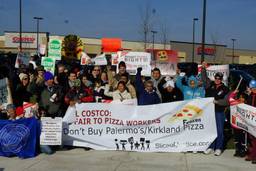Workers say conditions have improved, but response rate raises concern
Last month, Rutgers University released a report surveying New Jersey home-based caregivers on their working conditions, their career aspirations, and their views of their still-young union. The survey aimed to offer a snapshot of the workforce five years after unionization. The responses indicate both progress and pitfalls.
The report, Giving Voice to New Jersey’s Caregivers: The Union Experiences of Home-Based Child Care Providers, was published by Rutgers’ Center for Women and Work (CWW). It was authored by Widener University Assistant Professor Linda Houser, CWW research associate Elizabeth Nisbet, and CWW’s Director of Work and Family Programs, Karen White. White serves on the executive board of the Union of Rutgers Administrators, an American Federation of Teachers Affiiate. The report received funding from the pro-union American Rights at Work Education Fund.
Private sector domestic workers are among the workers excluded from legal union recognition under the National Labor Relations Act. In recent decades, unions organizing in the public sector have devoted increasing attention to legislative and organizing campaigns to win recognition and collective bargaining for workers paid by state governments to work in homes. In New Jersey, home-based child care workers organized with two international unions, the American Federation of State, County and Municipal Employees (AFSCME) and the Communication Workers of America (CWA). AFSCME and CWA created a joint affiliate, the Child Care Workers Union, and in 2006, 7,000 workers won bargaining rights in an executive order signed by then-Governor Jon Corzine. Ten New Jersey counties were assigned to CWA, and eleven to AFSCME. Workers ratified their first union contract in November 2007.
The authors note that the home-based, government-paid child care sector grew dramatically following the 1996 “welfare reform” act, which was ostensibly intended to push poor people to find work. The act replaced “Aid to Families with Dependent Children” (AFDC) with “Temporary Assistance to Needy Families” (TANF). By placing a lifetime time limit on support for the poor, and demanding poor people find jobs (including public-private hybrid “Workfare” programs), rather than staying at home with young children or attending school, the act increased both the supply of child care workers and the demand for their services.
According to CWW, AFSCME chose to participate in its study, while CWA declined. Working off of an address list provided by AFSCME, the authors mailed out surveys to roughly 2,000 union members, all of whom are employed through the state to care for other people’s children in their own homes (some also care for their own children at the same time). 148 sent back completed, anonymous surveys (they received a $10 gift card as compensation). As the authors acknowledge, with that response rate comes a selection bias: the attitudes of those who responded may differ significantly from those of the workers who didn’t. It also illustrates a challenge in the industry, where workers work alone and come into contact with peers only outside of work, or not at all.
Of the addresses AFSCME received from the state of New Jersey and provided to CWW, over a hundred surveys quickly came back in the mail as bad addresses. Houser says that based on her interviews with union staff, “That is the consistent experience of the union across the years that it’s been in operation.” Houser says the survey process “does highlight for us how inaccurate, in many cases, the [state-provided] lists that AFSCME and, I would assume, CWA [are] using” are. Houser talked to a child care worker who organizes for the union. She says that while this worker told her she helps keep contact information on nearby workers up to date, “it’s a very big gap, and she’s one person.” Houser says that incomplete info has led to a discrepancy between the number of members in the union and the number actually paying dues, and that AFSCME “worries about the areas that they haven’t connected with as strongly.” That challenge takes on particular significance as the union returns to the bargaining table to renegotiate its contract.
Those workers who did respond generally answered positively regarding how their work had changed since unionization, with majorities reporting improvement in categories like “Access to training or education opportunities” (63 percent), and “Ability to get my complaints or problems as a child care provider solved” (56 percent). Only 44 percent said that “subsidy per child” had increased (45 percent reported “No change”), even though the union contract had guaranteed a higher reimbursement rate. Citing conversations with union organizers, the authors said that workers may have been reacting to news reports that those levels could be endangered, or a lack of previous knowledge of the rates.
The responses also show the health care challenges facing the union members. Only 64 percent of respondents reported that they have health insurance. Of those, 61 percent are insured through a government program, 27 percent are insured on a partner’s plan, and 16 percent have a privately-purchased plan. Houser says this illustrates the importance of the union’s initiative to arrange group purchase of private insurance for workers who don’t qualify for a public plan but can’t afford most private ones. “What we see the New Jersey union able to do,” says Houser, “is to facilitate a health insurance option for the care providers that only works because they’re in it together.”
With the rise of organizing by home-based workers came a round of critics questioning the legitimacy of their status as workers or union members, suggesting that the government was colluding with unions to extract dues from people who would otherwise do the same tasks for free. The survey responses paint a different picture. The average tenure of a respondent was 12.5 years of child care work. Eighty-two percent had recently received training in the past year. Eighty-two percent said they plan to continue doing such work after their own children outgrow childcare. Twenty percent work with children with special needs, and 20 percent want training on working with children with special needs. Houser says that while workers still have to pay out-of-pocket for training, the union has been able to get less expensive rates by arranging group sessions.
At AFSCME’s request, CWW also asked questions regarding New Jersey’s newly-mandated attendance system, e-Child Care. Under this system, parents will call, from workers’ homes, to register when they drop off and pick of their kids. Sixty-three percent of respondents expressed support for the upcoming system. But the authors, echoing concerns raised by AFSCME staff, suggest that respondents’ other answers may bode poorly for its impact: “Full implementation of e-childcare requires that providers have land line phone, internet access, and a dedicated banking account for their business.” But most of the survey respondents don’t. “In a very real way,” they warn, “making parents responsible for confirming their child’s drop-off and pick-up times shifts the power over subsidy reimbursement from providers’ to parents’ hands.” They note that pay is already an issue — both the rate, which may fall below minimum wage, and the long and unpredictable delay involved in receiving it.
“This whole issue of taking a geographically dispersed and historically independent workforce and bringing it together is, in and of itself, a challenge…” says Houser. “The ways the union has brought them together in areas like health insurance and training, to open up opportunities for a disadvantaged workforce, is exciting and potentially a new space of the union movement.”






